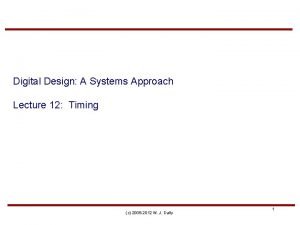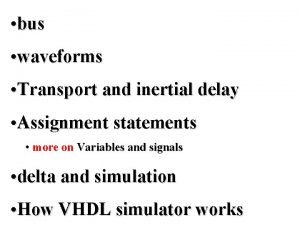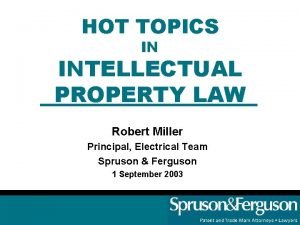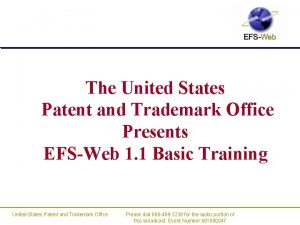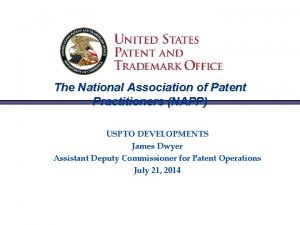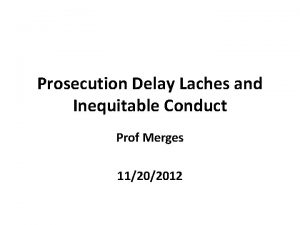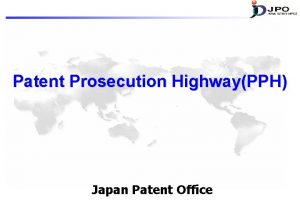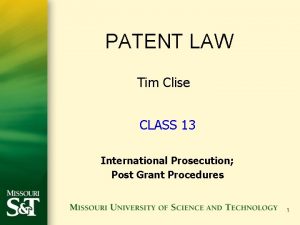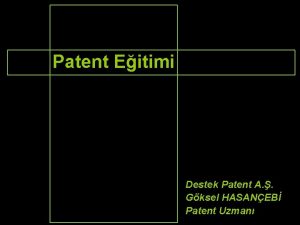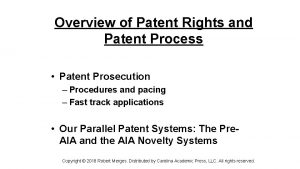Prosecution Delay Laches 4 26 04 Patent Law













- Slides: 13

Prosecution Delay Laches 4. 26. 04 Patent Law

United States Patent 5, 351, 078 Lemelson * September 27, 1994 Apparatus and methods for automated observation of objects Apparatus and methods are disclosed for automatically inspecting two- or threedimensional objects or subjects. A detector and the object are moved relative to each other. In one form, a detector, such as a camera or radiation receiver, moves around an object, which is supported to be rotatable such that the detector may receive electromagnetic energy signals from the object from a variety of angles. The energy may be directed as a beam at and reflected from the object, as for visible light, or passed through the object, as for x-ray radiation.

The detector generates analog image signals resulting from the detected radiation, and an electronic computer process and analyzes the analog signals and generates digital codes, which may be stored or employed to control a display.

Inventors: Lemelson; Jerome H. (Incline Village, NV) Assignee: Lemelson Medical, Education & Research Foundation Limited Partnership (Incline Village, NV) Filed: September 16, 1993



“Continuation Abuse” • Mark A. Lemley and Kimberly A. Moore, "Ending Abuse of Patent Continuations" (November 1, 2003). Boalt Working Papers in Public Law. Paper 20.

Supreme Court of the United States. WOODBRIDGE et al. v. UNITED STATES. Decided Nov. 12, 1923.

Justice Taft

In this case we have a delay of 9 1/2 years in securing a patent that might have been had at any time in that period for the asking, and this for the admitted purpose of making the term of the monopoly square with the period when the commercial profit from it would be highest. Not until war or fear of war came was there likely to be a strong demand for rifled cannon and their improvement.

Hence the inventor, having put his order for the issue of a patent into the secret archives of the Patent Office in 1852, sat down and waited until after the Civil War came on in 1861 before seeking to avail himself of the patent, thus postponing the time when the public could freely enjoy it for nearly 10 years.

Meantime other inventors had been at work in the same field and had obtained patents without knowledge of the situation with respect to Woodbridge's invention.

This is not a case where evidence has to be weighed as to the purpose of the inventor. He avows his deliberate intention. This is not a case of abandonment. It is a case of forfeiting the right to a patent by designed delay.
 Epo patent prosecution highway
Epo patent prosecution highway Les lâches n'hériteront pas le royaume de dieu
Les lâches n'hériteront pas le royaume de dieu Propagation delay
Propagation delay Inertial delay and transport delay
Inertial delay and transport delay Normally closed timed closed contact symbol
Normally closed timed closed contact symbol Pre prosecution
Pre prosecution Hot topics in patent law
Hot topics in patent law Newton's first law and second law and third law
Newton's first law and second law and third law Si unit of newton's first law
Si unit of newton's first law Boyle's law charles law avogadro's law
Boyle's law charles law avogadro's law How to calculate boyle's law
How to calculate boyle's law Patent electronic business center
Patent electronic business center National association of patent practitioners
National association of patent practitioners English royal patent of 1662
English royal patent of 1662


